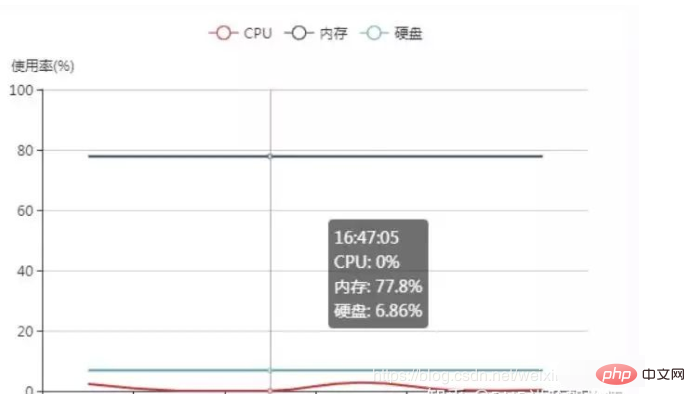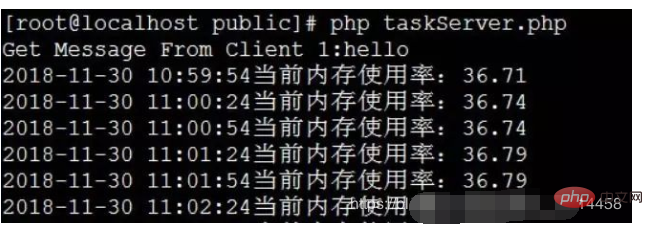php Swoole实现毫秒级定时任务

项目开发中,如果有定时任务的业务要求,我们会使用linux的crontab来解决,但是它的最小粒度是分钟级别,如果要求粒度是秒级别的,甚至毫秒级别的,crontab就无法满足,值得庆幸的是swoole提供的强大的毫秒定时器。
推荐学习: swoole教程
应用场景举例
我们可能会遇到这样的场景:
● 场景一:每隔30秒获取一次本机内存使用率
● 场景二:2分钟后执行报表发送任务
● 场景三:每天凌晨2点钟定时请求第三方接口,如果接口有数据返回则停止任务,如果接口由于某种原因没有响应或者没有数据返回则5分钟后继续尝试请求该接口,尝试5次后仍然失败则停止该任务
以上的三个场景我们都可以归纳为定时任务的范畴。
Swoole毫秒定时器
Swoole提供了异步毫秒定时器函数:
swoole_timer_tick(int $msec, callable $callback):设置一个间隔时钟定时器,每隔$msec毫秒执行一次$callback,类似于javascript中的setInterval()。
swoole_timer_after(int $after_time_ms, mixed $callback_function):在指定的时间$after_time_ms后执行$callback_function,类似于javascript的setTimeout()。
swoole_timer_clear(int $timer_id):删除指定id的定时器,类似于javascript的clearInterval()。
解决方案
对于场景一,经常用在系统检测统计方面,实时性要求比较高,但又能控制好频率,多用于后台服务器性能监控,可以生成可视化图表。可以是30秒获取一次内存使用率,也可以是10秒,而crontab最小粒度只能设置为1分钟。
swoole_timer_tick(30000, function($timer) use ($task_id) { // 启用定时器,每30秒执行一次
$memPercent = $this->getMemoryUsage(); //计算内存使用率
echo date('Y-m-d H:i:s') . '当前内存使用率:'.$memPercent."\n";
});
对于场景二,直接定义xx时间后执行某项任务的话,貌似crontab比较困难,而使用swoole的swoole_timer_after可以实现:
swoole_timer_after(120000, function() use ($str) { //2分钟后执行
$this->sendReport(); //发送报表
echo "send report, $str\n";
});
对于场景三,用来作尝试请求,请求失败后继续,如果成功则停止请求。用crontab也能解决,但是比较傻,比如设置每隔5分钟请求一次,不管成功会失败都会去执行一次。而用swoole定时器则智能多了。
swoole_timer_tick(5*60*1000, function($timer) use ($url) { // 启用定时器,每5分钟执行一次
$rs = $this->postUrl($url);
if ($rs) {
//业务代码...
swoole_timer_clear($timer); // 停止定时器
echo date('Y-m-d H:i:s'). "请求接口任务执行成功\n";
} else {
echo date('Y-m-d H:i:s'). "请求接口失败,5分钟后再次尝试\n";
}
});
示例代码
新建文件\src\App\Task.php:
<?php
namespace Helloweba\Swoole;
use swoole_server;
/**
* 任务调度
*/
class Task
{
protected $serv;
protected $host = '127.0.0.1';
protected $port = 9506;
// 进程名称
protected $taskName = 'swooleTask';
// PID路径
protected $pidPath = '/run/swooletask.pid';
// 设置运行时参数
protected $options = [
'worker_num' => 4, //worker进程数,一般设置为CPU数的1-4倍
'daemonize' => true, //启用守护进程
'log_file' => '/data/log/swoole-task.log', //指定swoole错误日志文件
'log_level' => 0, //日志级别 范围是0-5,0-DEBUG,1-TRACE,2-INFO,3-NOTICE,4-WARNING,5-ERROR
'dispatch_mode' => 1, //数据包分发策略,1-轮询模式
'task_worker_num' => 4, //task进程的数量
'task_ipc_mode' => 3, //使用消息队列通信,并设置为争抢模式
];
public function __construct($options = [])
{
date_default_timezone_set('PRC');
// 构建Server对象,监听127.0.0.1:9506端口
$this->serv = new swoole_server($this->host, $this->port);
if (!empty($options)) {
$this->options = array_merge($this->options, $options);
}
$this->serv->set($this->options);
// 注册事件
$this->serv->on('Start', [$this, 'onStart']);
$this->serv->on('Connect', [$this, 'onConnect']);
$this->serv->on('Receive', [$this, 'onReceive']);
$this->serv->on('Task', [$this, 'onTask']);
$this->serv->on('Finish', [$this, 'onFinish']);
$this->serv->on('Close', [$this, 'onClose']);
}
public function start()
{
// Run worker
$this->serv->start();
}
public function onStart($serv)
{
// 设置进程名
cli_set_process_title($this->taskName);
//记录进程id,脚本实现自动重启
$pid = "{$serv->master_pid}\n{$serv->manager_pid}";
file_put_contents($this->pidPath, $pid);
}
//监听连接进入事件
public function onConnect($serv, $fd, $from_id)
{
$serv->send( $fd, "Hello {$fd}!" );
}
// 监听数据接收事件
public function onReceive(swoole_server $serv, $fd, $from_id, $data)
{
echo "Get Message From Client {$fd}:{$data}\n";
//$this->writeLog('接收客户端参数:'.$fd .'-'.$data);
$res['result'] = 'success';
$serv->send($fd, json_encode($res)); // 同步返回消息给客户端
$serv->task($data); // 执行异步任务
}
/**
* @param $serv swoole_server swoole_server对象
* @param $task_id int 任务id
* @param $from_id int 投递任务的worker_id
* @param $data string 投递的数据
*/
public function onTask(swoole_server $serv, $task_id, $from_id, $data)
{
swoole_timer_tick(30000, function($timer) use ($task_id) { // 启用定时器,每30秒执行一次
$memPercent = $this->getMemoryUsage();
echo date('Y-m-d H:i:s') . '当前内存使用率:'.$memPercent."\n";
});
}
/**
* @param $serv swoole_server swoole_server对象
* @param $task_id int 任务id
* @param $data string 任务返回的数据
*/
public function onFinish(swoole_server $serv, $task_id, $data)
{
//
}
// 监听连接关闭事件
public function onClose($serv, $fd, $from_id) {
echo "Client {$fd} close connection\n";
}
public function stop()
{
$this->serv->stop();
}
private function getMemoryUsage()
{
// MEMORY
if (false === ($str = @file("/proc/meminfo"))) return false;
$str = implode("", $str);
preg_match_all("/MemTotal\s{0,}\:+\s{0,}([\d\.]+).+?MemFree\s{0,}\:+\s{0,}([\d\.]+).+?Cached\s{0,}\:+\s{0,}([\d\.]+).+?SwapTotal\s{0,}\:+\s{0,}([\d\.]+).+?SwapFree\s{0,}\:+\s{0,}([\d\.]+)/s", $str, $buf);
//preg_match_all("/Buffers\s{0,}\:+\s{0,}([\d\.]+)/s", $str, $buffers);
$memTotal = round($buf[1][0]/1024, 2);
$memFree = round($buf[2][0]/1024, 2);
$memUsed = $memTotal - $memFree;
$memPercent = (floatval($memTotal)!=0) ? round($memUsed/$memTotal*100,2):0;
return $memPercent;
}
}
我们以场景一为例,在onTask启用定时任务,每隔30秒计算一次内存使用率。实际应用中可以把计算好的内存按时间写入数据库等存储中,然后可以根据前端需求用来渲染成统计图表,如:

接着服务端代码 public\taskServer.php :
<?php
require dirname(__DIR__) . '/vendor/autoload.php';
use Helloweba\Swoole\Task;
$opt = [
'daemonize' => false
];
$ser = new Task($opt);
$ser->start();
客户端代码 public\taskClient.php :
<?php
class Client
{
private $client;
public function __construct() {
$this->client = new swoole_client(SWOOLE_SOCK_TCP);
}
public function connect() {
if( !$this->client->connect("127.0.0.1", 9506 , 1) ) {
echo "Error: {$this->client->errMsg}[{$this->client->errCode}]\n";
}
fwrite(STDOUT, "请输入消息 Please input msg:");
$msg = trim(fgets(STDIN));
$this->client->send( $msg );
$message = $this->client->recv();
echo "Get Message From Server:{$message}\n";
}
}
$client = new Client();
$client->connect();
验证效果
1.启动服务端:
php taskServer.php
2.客户端输入:
另开命令行窗口,执行
[root@localhost public]# php taskClient.php
请输入消息 Please input msg:hello
Get Message From Server:{"result":"success"}
[root@localhost public]#
3.服务端返回:

如果返回上图中的结果,则定时任务正常运行,我们会发现每隔30秒会输出一条信息。
Atas ialah kandungan terperinci php Swoole实现毫秒级定时任务. Untuk maklumat lanjut, sila ikut artikel berkaitan lain di laman web China PHP!

Alat AI Hot

Undresser.AI Undress
Apl berkuasa AI untuk mencipta foto bogel yang realistik

AI Clothes Remover
Alat AI dalam talian untuk mengeluarkan pakaian daripada foto.

Undress AI Tool
Gambar buka pakaian secara percuma

Clothoff.io
Penyingkiran pakaian AI

AI Hentai Generator
Menjana ai hentai secara percuma.

Artikel Panas

Alat panas

Notepad++7.3.1
Editor kod yang mudah digunakan dan percuma

SublimeText3 versi Cina
Versi Cina, sangat mudah digunakan

Hantar Studio 13.0.1
Persekitaran pembangunan bersepadu PHP yang berkuasa

Dreamweaver CS6
Alat pembangunan web visual

SublimeText3 versi Mac
Perisian penyuntingan kod peringkat Tuhan (SublimeText3)

Topik panas
 1379
1379
 52
52
 Panduan Pemasangan dan Naik Taraf PHP 8.4 untuk Ubuntu dan Debian
Dec 24, 2024 pm 04:42 PM
Panduan Pemasangan dan Naik Taraf PHP 8.4 untuk Ubuntu dan Debian
Dec 24, 2024 pm 04:42 PM
PHP 8.4 membawa beberapa ciri baharu, peningkatan keselamatan dan peningkatan prestasi dengan jumlah penamatan dan penyingkiran ciri yang sihat. Panduan ini menerangkan cara memasang PHP 8.4 atau naik taraf kepada PHP 8.4 pada Ubuntu, Debian, atau terbitan mereka
 Cara Menyediakan Kod Visual Studio (Kod VS) untuk Pembangunan PHP
Dec 20, 2024 am 11:31 AM
Cara Menyediakan Kod Visual Studio (Kod VS) untuk Pembangunan PHP
Dec 20, 2024 am 11:31 AM
Kod Visual Studio, juga dikenali sebagai Kod VS, ialah editor kod sumber percuma — atau persekitaran pembangunan bersepadu (IDE) — tersedia untuk semua sistem pengendalian utama. Dengan koleksi sambungan yang besar untuk banyak bahasa pengaturcaraan, Kod VS boleh menjadi c
 7 Fungsi PHP Saya Menyesal Saya Tidak Tahu Sebelum ini
Nov 13, 2024 am 09:42 AM
7 Fungsi PHP Saya Menyesal Saya Tidak Tahu Sebelum ini
Nov 13, 2024 am 09:42 AM
Jika anda seorang pembangun PHP yang berpengalaman, anda mungkin merasakan bahawa anda telah berada di sana dan telah melakukannya. Anda telah membangunkan sejumlah besar aplikasi, menyahpenyahpepijat berjuta-juta baris kod dan mengubah suai sekumpulan skrip untuk mencapai op
 Bagaimana anda menghuraikan dan memproses HTML/XML dalam PHP?
Feb 07, 2025 am 11:57 AM
Bagaimana anda menghuraikan dan memproses HTML/XML dalam PHP?
Feb 07, 2025 am 11:57 AM
Tutorial ini menunjukkan cara memproses dokumen XML dengan cekap menggunakan PHP. XML (bahasa markup extensible) adalah bahasa markup berasaskan teks yang serba boleh yang direka untuk pembacaan manusia dan parsing mesin. Ia biasanya digunakan untuk penyimpanan data
 Jelaskan JSON Web Tokens (JWT) dan kes penggunaannya dalam PHP API.
Apr 05, 2025 am 12:04 AM
Jelaskan JSON Web Tokens (JWT) dan kes penggunaannya dalam PHP API.
Apr 05, 2025 am 12:04 AM
JWT adalah standard terbuka berdasarkan JSON, yang digunakan untuk menghantar maklumat secara selamat antara pihak, terutamanya untuk pengesahan identiti dan pertukaran maklumat. 1. JWT terdiri daripada tiga bahagian: header, muatan dan tandatangan. 2. Prinsip kerja JWT termasuk tiga langkah: menjana JWT, mengesahkan JWT dan muatan parsing. 3. Apabila menggunakan JWT untuk pengesahan di PHP, JWT boleh dijana dan disahkan, dan peranan pengguna dan maklumat kebenaran boleh dimasukkan dalam penggunaan lanjutan. 4. Kesilapan umum termasuk kegagalan pengesahan tandatangan, tamat tempoh, dan muatan besar. Kemahiran penyahpepijatan termasuk menggunakan alat debugging dan pembalakan. 5. Pengoptimuman prestasi dan amalan terbaik termasuk menggunakan algoritma tandatangan yang sesuai, menetapkan tempoh kesahihan dengan munasabah,
 Program PHP untuk mengira vokal dalam rentetan
Feb 07, 2025 pm 12:12 PM
Program PHP untuk mengira vokal dalam rentetan
Feb 07, 2025 pm 12:12 PM
Rentetan adalah urutan aksara, termasuk huruf, nombor, dan simbol. Tutorial ini akan mempelajari cara mengira bilangan vokal dalam rentetan yang diberikan dalam PHP menggunakan kaedah yang berbeza. Vokal dalam bahasa Inggeris adalah a, e, i, o, u, dan mereka boleh menjadi huruf besar atau huruf kecil. Apa itu vokal? Vokal adalah watak abjad yang mewakili sebutan tertentu. Terdapat lima vokal dalam bahasa Inggeris, termasuk huruf besar dan huruf kecil: a, e, i, o, u Contoh 1 Input: String = "TutorialSpoint" Output: 6 menjelaskan Vokal dalam rentetan "TutorialSpoint" adalah u, o, i, a, o, i. Terdapat 6 yuan sebanyak 6
 Terangkan pengikatan statik lewat dalam php (statik: :).
Apr 03, 2025 am 12:04 AM
Terangkan pengikatan statik lewat dalam php (statik: :).
Apr 03, 2025 am 12:04 AM
Mengikat statik (statik: :) Melaksanakan pengikatan statik lewat (LSB) dalam PHP, yang membolehkan kelas panggilan dirujuk dalam konteks statik dan bukannya menentukan kelas. 1) Proses parsing dilakukan pada masa runtime, 2) Cari kelas panggilan dalam hubungan warisan, 3) ia boleh membawa overhead prestasi.
 Apakah kaedah Magic PHP (__construct, __destruct, __call, __get, __set, dll) dan menyediakan kes penggunaan?
Apr 03, 2025 am 12:03 AM
Apakah kaedah Magic PHP (__construct, __destruct, __call, __get, __set, dll) dan menyediakan kes penggunaan?
Apr 03, 2025 am 12:03 AM
Apakah kaedah sihir PHP? Kaedah sihir PHP termasuk: 1. \ _ \ _ Membina, digunakan untuk memulakan objek; 2. \ _ \ _ Destruct, digunakan untuk membersihkan sumber; 3. \ _ \ _ Call, mengendalikan panggilan kaedah yang tidak wujud; 4. \ _ \ _ Mendapatkan, melaksanakan akses atribut dinamik; 5. \ _ \ _ Set, melaksanakan tetapan atribut dinamik. Kaedah ini secara automatik dipanggil dalam situasi tertentu, meningkatkan fleksibiliti dan kecekapan kod.




